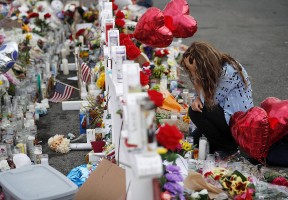

By: Ashmar Mandou
This past weekend, dual massacres occurred in El Paso, Texas, and Dayton, Ohio. At least 31 people were killed, and dozens more were injured in these mass shootings. However, according to data collected by the Gun Violence Archive, the phenomenon isn’t new. Since 2014, there have been 334 mass shootings per year, on average, in the US. (The Gun Violence Archive defines a mass shooting event as one in which at least four people were killed or injured.) With so many mass shootings every year, the probability is high that on any given day there is more than one incident. Since 2014, there have been 484 individual days with two or more mass shootings—on 407 of those days, at least one person was killed. And that doesn’t include events like this past weekend, when shootings happen within 24 hours but on consecutive days. Here is what we know about mass shootings.
What weapons are most frequently used in mass shooting incidents?
Here is a breakdown of the weapons used in each of the 64 mass shootings from 2000 to 2018:
Handgun: 28
Rifle: 11
Rifle and handgun: 9
Shotgun and handgun: 6
Rifle, shotgun, and handgun: 5
Rifle and shotgun: 3
Shotgun: 2
What is the gender of mass shooters?
Of the 64 mass shootings from 2000 to 2018, 61 were by men, two were by women, and one incident included one man and one woman (a husband and wife).
Is mental illness a primary factor in mass shootings?
A study of mass killers found the majority exhibited no evidence of a severe mental disorder, such as psychosis or hallucinations. The 2016 analysis of 71 lone-actor terrorists and 115 mass killers also found the rate of psychotic disorders to be roughly 20 percent. The overall rate of any psychiatric history among mass killers—including such probable diagnoses as depression, learning disabilities, or ADHD—was 48 percent. However, about two-thirds of this group had faced long-term stress, and more than 40 percent had problems with alcohol, marijuana, or other drugs. Yet as American Psychological Association president Rosie Phillips Davis noted after the recent shootings, “The rates of mental illness are roughly the same around the world, yet other countries are not experiencing these traumatic events as often as we face them.”
According to the American College of Emergency Physician, firearm injuries—accidental or otherwise—should be addressed as a public health epidemic, with investments in research and a sweeping commitment to change that matches or exceeds the level of a number of diseases, outbreaks or disorders that capture the public conscience but have exacted far less of a human toll in recent years. “News reports are numbing, and even the most well-intentioned thoughts and prayers fall short. As emergency physicians, we are on the frontlines of treating the victims of these senseless, violent acts. The frequency of firearm injuries and fatalities in this country is staggering, and there is no doubt about the threat posed to America’s public health and safety.”











